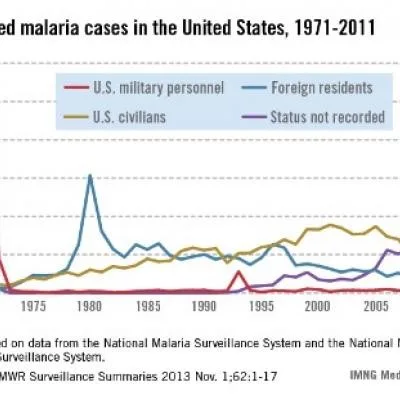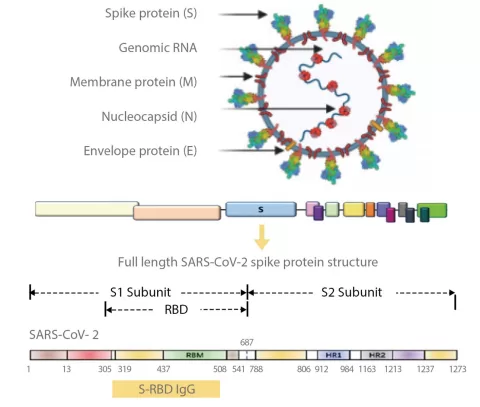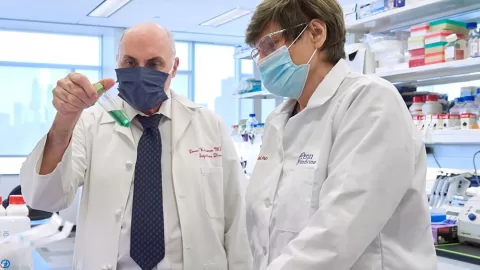Corynebacterium diphtheriae is the bacterium responsible for diphtheria, a serious infectious disease that poses significant public health concerns, especially in vulnerable populations. Recent diphtheria outbreaks in Germany have highlighted the urgency to monitor and control this pathogen, particularly among persons experiencing homelessness who engage in intravenous drug use. The rise of cutaneous diphtheria cases, linked to the 2022 European outbreak, underscores the need for increased vigilance and vaccination efforts. As C. diphtheriae is primarily spread through respiratory droplets and skin contact, understanding its transmission dynamics is essential for effective public health strategies. Vaccination against diphtheria remains crucial in preventing infections and protecting communities from potential outbreaks.
Corynebacterium diphtheriae, often referred to simply as diphtheria bacteria, is a major concern in global health due to its role in causing diphtheria, a potentially life-threatening disease. This pathogen is notorious for its ability to spread easily among populations, particularly in environments where hygiene is compromised, such as among individuals with substance use disorders. The emergence of cutaneous infections has raised alarms, especially when linked to recent diphtheria outbreaks in Europe. Public health initiatives emphasizing diphtheria vaccination are essential for controlling transmission and preventing future cases. Understanding the epidemiology of this bacterium is vital for developing effective interventions and safeguarding at-risk communities.
Understanding Corynebacterium diphtheriae and Diphtheria Outbreaks
Corynebacterium diphtheriae is the bacterium responsible for diphtheria, a serious infectious disease that primarily affects the throat and skin. The bacteria can cause severe respiratory issues when it infects the larynx or pharynx, leading to potential complications and even death if left untreated. Diphtheria outbreaks have been reported globally, with significant public health implications, particularly in vulnerable populations such as those experiencing homelessness. The recent cases in Frankfurt, Germany, highlight the urgent need for awareness and preventive measures to combat the spread of this disease.
In 2022, Europe saw a resurgence of diphtheria cases, linked to various contributing factors, including increased intravenous drug use among individuals without stable housing. The connection between these outbreaks and the presence of toxigenic strains of C. diphtheriae among people engaged in high-risk behaviors underscores the importance of targeted public health interventions. Identifying and controlling outbreaks requires both effective surveillance systems and community engagement to ensure that high-risk populations receive necessary vaccinations and healthcare support.
The Impact of Cutaneous Diphtheria in Vulnerable Populations
Cutaneous diphtheria, often arising in individuals with compromised immune systems or those living in unsanitary conditions, poses significant risks to public health. The recent identification of additional cases among persons experiencing homelessness in Germany emphasizes the need for increased vigilance and resources dedicated to these communities. Skin lesions can serve as a transmission source for C. diphtheriae, making it imperative to monitor and treat such infections promptly to prevent further spread.
Furthermore, the link between cutaneous diphtheria and intravenous drug use cannot be overlooked. The sharing of needles and other paraphernalia can lead to skin infections that may be complicated by the presence of C. diphtheriae. Public health initiatives must address these intersecting issues by providing safe injection resources, access to wound care, and education about the importance of diphtheria vaccination. Such comprehensive approaches can help mitigate outbreaks and protect the health of vulnerable populations.
Public Health Strategies in Germany for Diphtheria Prevention
In response to the rise of diphtheria cases, especially among high-risk groups, public health authorities in Germany are re-evaluating their strategies for diphtheria prevention and control. The integration of vaccination campaigns tailored to the needs of vulnerable populations is crucial. Ensuring that individuals experiencing homelessness have access to vaccinations and healthcare services can significantly reduce the incidence of diphtheria and its associated complications.
Moreover, public health education plays a vital role in fostering awareness about diphtheria and its transmission routes. By informing communities about the dangers of sharing needles and the importance of hygiene, authorities can empower individuals to take preventive measures. Engaging with local organizations that work closely with people experiencing homelessness can enhance outreach efforts and ensure that these populations are informed about available health resources.
Linking Diphtheria Vaccination with Outbreak Control
Vaccination remains the most effective strategy in controlling diphtheria outbreaks. The recent cases of Corynebacterium diphtheriae infections in Frankfurt have reignited discussions on the importance of maintaining high vaccination coverage among at-risk populations. Ensuring that everyone, especially those experiencing homelessness or engaging in intravenous drug use, is vaccinated can prevent the spread of this disease and protect public health.
Public health officials must advocate for booster vaccinations in communities experiencing dips in immunization rates. The correlation between low vaccination coverage and the resurgence of diphtheria outbreaks highlights the need for ongoing education and funding to support immunization programs. By prioritizing vaccination efforts, especially in areas with reported cases of cutaneous diphtheria or respiratory infections, officials can work towards a significant reduction in diphtheria incidence across Germany.
Genomic Analysis in Tracking Diphtheria Outbreaks
Genomic analysis has emerged as a powerful tool in tracking the genetic relationships between cases of diphtheria and understanding the dynamics of outbreaks. In the recent investigation in Frankfurt, the identification of sequence type 574 among cases of C. diphtheriae provided crucial insights into the ongoing outbreak’s lineage and its connection to previous outbreaks in Europe. This information can inform public health responses and help target interventions more effectively.
By utilizing genomic data, health authorities can identify transmission pathways and potential reservoirs of infection, particularly in communities at higher risk. This approach allows for a more nuanced understanding of how diphtheria spreads, thereby informing strategies aimed at both prevention and treatment. Increased investment in genomic surveillance will be essential in enhancing outbreak preparedness and response efforts, particularly in light of the rising trend of diphtheria cases linked to social determinants of health.
The Role of Community Health Initiatives in Diphtheria Management
Community health initiatives play a crucial role in managing diphtheria outbreaks, especially among susceptible populations. These programs can provide education, resources, and support to individuals at risk, promoting vaccination and hygiene practices to reduce transmission. For example, outreach efforts aimed at those engaged in intravenous drug use can significantly impact their awareness and access to care, ultimately contributing to a decline in diphtheria cases.
Additionally, partnerships between public health authorities and local organizations can enhance the reach of these initiatives. By leveraging existing community networks, health officials can ensure that information about diphtheria and available health services reaches those most in need. Such collaborative efforts are vital for building trust and encouraging individuals to seek the care they require to prevent and address infections.
Addressing Behavioral Risk Factors in Diphtheria Prevention
Behavioral risk factors significantly influence the spread of diphtheria, particularly among marginalized populations. Intravenous drug use is a notable factor, as it often leads to increased susceptibility to infections, including cutaneous diphtheria. Addressing these behaviors through harm reduction strategies, such as needle exchange programs and safe consumption spaces, can mitigate the risks associated with drug use and reduce the likelihood of diphtheria outbreaks.
Moreover, educational campaigns focusing on the dangers of sharing needles and promoting safe practices can empower individuals to make informed choices about their health. By prioritizing behavioral interventions alongside vaccination efforts, public health initiatives can create a more comprehensive approach to diphtheria prevention, ultimately reducing the incidence of the disease among high-risk groups.
Monitoring and Surveillance in Diphtheria Control
Effective monitoring and surveillance systems are essential for controlling diphtheria outbreaks. The recent cases in Frankfurt highlight the critical need for timely reporting and investigation of infections to understand transmission dynamics and implement appropriate public health responses. Surveillance efforts should focus on identifying not only respiratory cases but also cutaneous diphtheria, as both forms of the disease can contribute to public health threats.
Investing in robust surveillance systems that incorporate genomic analysis can enhance outbreak detection and response capabilities. By ensuring that health authorities have access to real-time data on diphtheria cases, they can better allocate resources and implement targeted interventions to control the spread of the disease. Continuous monitoring of high-risk populations is vital for preventing future outbreaks and protecting public health.
The Importance of Public Awareness Campaigns for Diphtheria
Public awareness campaigns are crucial in enhancing community knowledge about diphtheria prevention and control measures. These campaigns can educate the public about the symptoms of diphtheria, the importance of vaccination, and the need for prompt medical attention in case of suspected infections. By raising awareness, health authorities can empower individuals to take proactive steps in protecting their health and the health of their communities.
Furthermore, targeted campaigns aimed at vulnerable populations, such as those experiencing homelessness or engaging in high-risk behaviors, can significantly improve health outcomes. These initiatives can provide critical information about available health services, including vaccination clinics and wound care resources, ultimately contributing to a reduction in diphtheria cases. Engaging community leaders and local organizations in these efforts can enhance outreach and ensure that the message reaches those most at risk.
Frequently Asked Questions
What is Corynebacterium diphtheriae and how does it relate to diphtheria outbreaks?
Corynebacterium diphtheriae is the bacterium that causes diphtheria, a serious infectious disease that can lead to respiratory issues and skin infections. Recent diphtheria outbreaks, particularly in Europe, have highlighted the importance of monitoring this pathogen, especially in vulnerable populations such as persons experiencing homelessness.
How does intravenous drug use contribute to the spread of Corynebacterium diphtheriae?
Intravenous drug use can increase the risk of Corynebacterium diphtheriae infections due to shared needles and lack of hygiene, leading to cutaneous diphtheria. This was notably observed in cases reported in Frankfurt, Germany, among persons experiencing homelessness.
Why is cutaneous diphtheria a public health concern in Germany?
Cutaneous diphtheria poses a public health threat as it can spread through direct contact with infected skin lesions. The recent detection of cutaneous toxigenic C. diphtheriae in Frankfurt highlights the need for heightened awareness and prevention measures, especially following diphtheria outbreaks.
What role does diphtheria vaccination play in preventing Corynebacterium diphtheriae infections?
Diphtheria vaccination is crucial in preventing infections caused by Corynebacterium diphtheriae. Vaccination helps build immunity within communities, reducing the risk of diphtheria outbreaks and protecting vulnerable populations, particularly those with increased exposure risks.
How can genomic analysis aid in understanding Corynebacterium diphtheriae outbreaks?
Genomic analysis allows health authorities to identify genetic relationships among strains of Corynebacterium diphtheriae involved in outbreaks. This information is vital for tracking transmission patterns and implementing effective public health responses, especially in light of the 2022 diphtheria outbreak in Europe.
What measures are being taken to control diphtheria outbreaks linked to Corynebacterium diphtheriae?
In response to the diphtheria outbreaks, public health officials in Germany are enhancing detection and monitoring of Corynebacterium diphtheriae, particularly among high-risk groups such as persons experiencing homelessness. Efforts include promoting vaccination and improving hygiene practices.
What are the symptoms of cutaneous diphtheria caused by Corynebacterium diphtheriae?
Symptoms of cutaneous diphtheria include the appearance of painful, non-healing sores or ulcers on the skin, often accompanied by a grayish membrane. These symptoms may arise in individuals who are at higher risk, such as those involved in intravenous drug use.
How does the transmission of Corynebacterium diphtheriae occur?
Corynebacterium diphtheriae is primarily transmitted through respiratory droplets from infected individuals or via direct contact with skin lesions. It can also spread through contaminated objects, making hygiene and vaccination critical in preventing its spread.
What is the incubation period for infections caused by Corynebacterium diphtheriae?
The incubation period for infections caused by Corynebacterium diphtheriae typically ranges from 2 to 5 days, although it can be as short as 1 day or as long as 10 days. Awareness of this period is essential for early detection and intervention.
Why is monitoring for Corynebacterium diphtheriae important in public health?
Monitoring for Corynebacterium diphtheriae is essential for public health as it helps identify outbreaks, understand transmission dynamics, and implement timely interventions to protect vulnerable populations and prevent widespread disease.
| Key Point | Details |
|---|---|
| Corynebacterium diphtheriae Infections | Associated with intravenous drug use among persons experiencing homelessness (PEH) in Frankfurt, Germany, in 2023. |
| Investigations | Three additional cases of cutaneous toxigenic C. diphtheriae were detected from swab samples collected from 36 PEH. |
| Genetic Findings | Sequence type 574 was identified in five case isolates, linked to clusters from the 2022 outbreak. |
| Public Health Implications | Highlights the need for increased detection, monitoring, and booster immunizations in high-risk groups. |
| Diphtheria Overview | A vaccine-preventable disease primarily affecting the respiratory tract and skin, transmitted via respiratory droplets or contact. |
| Incubation and Co-Infections | Typically 2–5 days, may co-occur with other pathogens like Streptococcus pyogenes. |
Summary
Corynebacterium diphtheriae is a significant public health concern, particularly among vulnerable populations such as those experiencing homelessness. Recent outbreaks in Frankfurt, Germany, have highlighted the urgent need for enhanced surveillance and immunization efforts against diphtheria. The detection of toxigenic strains associated with intravenous drug use underscores the importance of monitoring transmission routes and potential co-infections. Overall, proactive measures are essential to prevent further spread and ensure community health.
The content provided on this blog (e.g., symptom descriptions, health tips, or general advice) is for informational purposes only and is not a substitute for professional medical advice, diagnosis, or treatment. Always seek the guidance of your physician or other qualified healthcare provider with any questions you may have regarding a medical condition. Never disregard professional medical advice or delay seeking it because of something you have read on this website. If you believe you may have a medical emergency, call your doctor or emergency services immediately. Reliance on any information provided by this blog is solely at your own risk.








